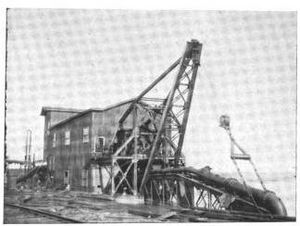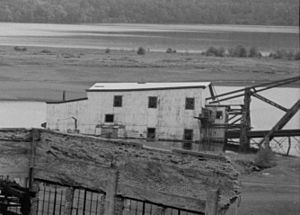Quincy Dredge Number Two facts for kids
Quick facts for kids Calumet and Hecla/Quincy Reclaiming Sand Dredge |
|
|---|---|
 |
|
| Location | M-26 near Torch Lake, Osceola Township |
| Built | 1914 |
| Governing body | State |
| Designated | July 26, 1978 |
| Lua error in Module:Location_map at line 420: attempt to index field 'wikibase' (a nil value). | |
The Quincy Dredge Number Two is a large machine that floats on water. It was once called the Calumet and Hecla Dredge Number One. This special boat is now resting in the shallow waters of Torch Lake. You can find it near M-26, close to the Quincy Mining Company Stamp Mills Historic District and the town of Mason in Osceola Township.
This dredge was built to collect "stamping sand" from the lake. This sand had tiny bits of copper that could be processed again. In 1978, it was recognized as a Michigan State Historic Site because of its important history.
Contents
What is the Quincy Dredge?
A dredge is like a giant vacuum cleaner for the bottom of a lake or river. It sucks up sand, mud, or other materials. The Quincy Dredge was used to reclaim, or get back, valuable copper from sand that had already been processed once.
History of the Quincy Dredge
The Reclaiming Sand Dredge was built in 1914 for the Calumet and Hecla Mining Company. It was made by the Bucyrus Company in South Milwaukee, Wisconsin. They named it the Calumet and Hecla Dredge Number One.
Why was the dredge used?
The dredge's main job was to collect sand that had been dumped into the lake. This sand was left over after copper ore went through a "stamp mill." A stamp mill crushed rocks to get copper out.
Earlier methods of crushing rocks weren't perfect. They left small amounts of copper in the leftover sand. Over time, new technology made it possible to get this leftover copper. It also became more expensive to dig for new copper deep underground. So, reclaiming the sand became a good way to get more copper.
Who owned the dredge?
The Calumet and Hecla Mining Company used this dredge at their Lake Linden Reclamation Plant. They used it until 1951.
In 1951, the Quincy Mine bought the dredge. They renamed it the Quincy Dredge Number Two. They used it at their own reclamation facility, which had been working since 1943.
When did the dredge stop working?
The Quincy Mine had another dredge, Quincy Dredge Number One, which sank in 1956. So, Dredge Number Two became even more important.
However, in 1967, the Quincy Dredge Number Two also sank. This happened during the winter when it was not in use. Around this time, copper prices dropped very low. It was no longer profitable to reclaim copper from the sand. Because of this, the Quincy Mine stopped using the dredge and closed its reclamation facility.
What the Dredge Looks Like
The dredge is a very large, box-shaped boat. It was designed to scoop sand from the bottom of the lake. Its main body, called the hull, is made of steel. It measures about 110 feet (33.5 meters) long. It is also 56 feet (17 meters) wide and 9 feet (2.7 meters) deep.
The top deck of the dredge hangs over the hull by about 8 feet (2.4 meters) on each side. This makes the total width about 72 feet (22 meters).
This powerful machine could process over 10,000 short tons (9,072 metric tons) of sand every day! It had a long suction pipe, about 141 feet (43 meters) long. This pipe could reach down into water as deep as 115 feet (35 meters).
Today, the dredge is still sunk in the shallow water of Torch Lake. It is tilted to one side. You can still see most of its top structure and the large boom (a long arm) above the water.




